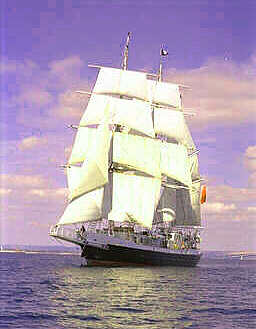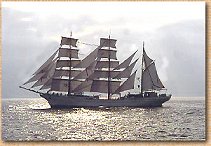
The Story of the Seahorse
 When
you mention the "Seahorse" in Tramore, you immediately think of a tall sailing ship which
met its fate just off the beach many years ago, with the loss of many lives. It has become the symbol of
many clubs and organizations in the Waterford
area. We have it on our school crest. It is also used
on the crest of Tramore Golf club. In fact, it is also the logo for
Waterford Crystal ,which produces the finest hand -cut glass in the world.
When
you mention the "Seahorse" in Tramore, you immediately think of a tall sailing ship which
met its fate just off the beach many years ago, with the loss of many lives. It has become the symbol of
many clubs and organizations in the Waterford
area. We have it on our school crest. It is also used
on the crest of Tramore Golf club. In fact, it is also the logo for
Waterford Crystal ,which produces the finest hand -cut glass in the world.Here is the story of this famous sea tragedy. The Seahorse was a sailing transport ship. It was built in London in 1784. A vessel of 350 tons, it was constructed of Irish Oak. It was originally a three deck, three masted, fighting vessel commanded by Lord Nelson in 1799. On her last voyage from Ramsgate in England to Cork in Ireland she was commanded by a Captain Gibbs, with an Irishman, John Sullivan as first mate and a crew of 17 men. On board were 16 officers, 287 soldiers, 33 women and 38 children.
The Seahorse left Ramsgate on the 25th January 1816, in calm weather and anchored overnight in the Downs. The following morning she weighed anchor and with light breezes from the North / North West she was off Dungeness about midnight. Two days later, on the 28th January she was off Lizards Point with the wind blowing from the South sending her past the Wolf Rock, between Lands End and St. Mary’s on the Scilly Isles and out across St. George’s Channel into the Atlantic.
 On the 29th January a strong South/South Easterly
wind sprung up and by 4 pm Ballycotton Island was sited about 12 miles away. As the wind
increased and the seas rose Captain Gibbs headed for Kinsale Lights to sail down the coast
to Cork.John Sullivan, the first mate, was the only man aboard who
knew the South coast.Due to the poor visibility it was impossible for the Captain
to fix his position and the ship was blown Eastwards. When no lights appeared, John
Sullivan climbed the rigging to view the land. A fierce wind gust tore him from the
rigging and smashed him to the deck. He died 3 hours later.
On the 29th January a strong South/South Easterly
wind sprung up and by 4 pm Ballycotton Island was sited about 12 miles away. As the wind
increased and the seas rose Captain Gibbs headed for Kinsale Lights to sail down the coast
to Cork.John Sullivan, the first mate, was the only man aboard who
knew the South coast.Due to the poor visibility it was impossible for the Captain
to fix his position and the ship was blown Eastwards. When no lights appeared, John
Sullivan climbed the rigging to view the land. A fierce wind gust tore him from the
rigging and smashed him to the deck. He died 3 hours later.
About 5am on the 30th January Minehead appeared . The gale was now severe, and the vessel was drifting fast, and though Hook Lighthouse was visible, it was not possible to sail around Brownstown Head, and about midday with the wind and sea still increasing the Seahorse, battered and helpless grounded in Tramore Bay less than a mile from the shore and safety.
Only 30 people survived none of them were women or children.
Later there was a monument erected in their memories.
Because of erosion their remains had to be moved to a safer place. The monument is now on
the Doneraile Walk, which affords a spectacular view of Tramore Bay, where many souls lost
their lives to the sea on that dreadful night in 1816.
Michael Coghlan